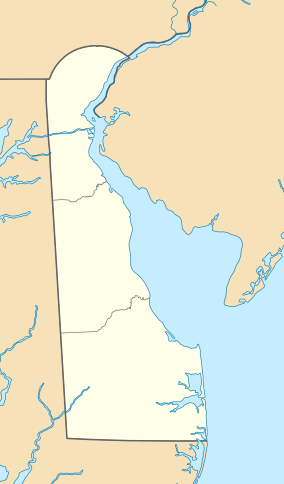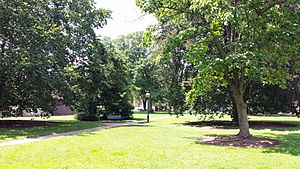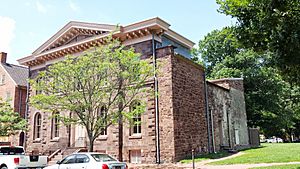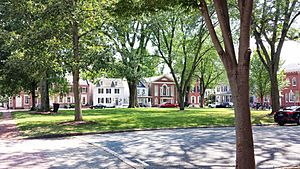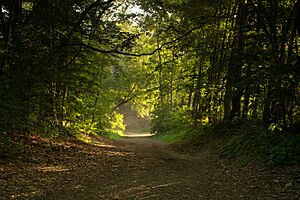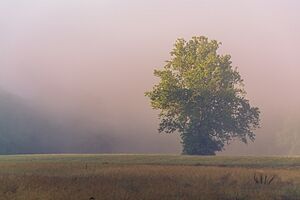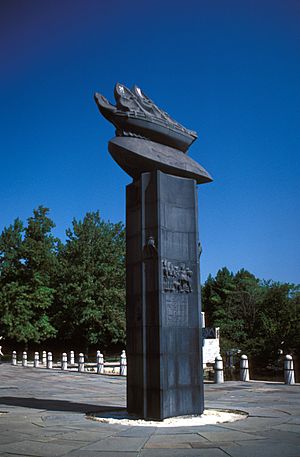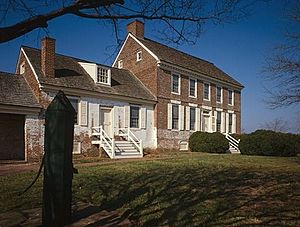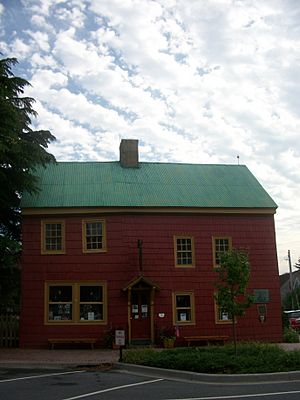First State National Historical Park facts for kids
Quick facts for kids First State National Historical Park |
|
|---|---|

New Castle Court House
|
|
| Location | New Castle / Kent / Sussex counties, Delaware and Delaware County, Pennsylvania, United States |
| Nearest city | Dover, Lewes, New Castle, and Wilmington, Delaware |
| Created | March 25, 2013 |
| Governing body | National Park Service, State |
| Website | First State National Historical Park |
The First State National Historical Park is a special place managed by the National Park Service. Most of it is in Delaware, but a small part reaches into Pennsylvania. This park was first created by President Barack Obama in 2013 as a National Monument. Later, the U.S. Congress changed its name to First State National Historical Park.
Contents
Discovering Delaware's History
This park helps us learn about the early history of Delaware. It shows how Delaware played a big part in forming the United States. Delaware was actually the very first state to agree to the U.S. Constitution!
The park also tells the unique story of how different groups settled the Delaware Valley. These groups included the Dutch, Swedes, Finns, and English. It also explores their relationships with the Native Americans who lived there first. The park also works to protect the beautiful natural areas around the Brandywine River.
Russ Smith, the park's first leader, explained its purpose. He said it helps people see that American history isn't just about places like Jamestown or Plymouth Rock. He pointed out that 13 different traditions grew in the 1600s, which later came together in 1776.
He also highlighted the amazing diversity of settlers in Delaware. People from the Netherlands, Germany, France, and Belgium all came to the Delaware Valley in the 1600s. Delaware also had a tradition of tolerance. This meant people had freedom of religion on the Delaware River even before William Penn arrived. This was different from other colonies where people were sometimes jailed for their beliefs.
Park Locations
The First State National Historical Park is made up of several important historical sites. Each site tells a different part of Delaware's story.
New Castle Court House, Green, and Sheriff's House
The New Castle Court House was built in 1730. It is one of the oldest courthouses in the United States. Many important events that shaped the nation happened here.
The very top of the Court House is the center of a special 12-mile circle. This circle helps form the border between Delaware, Pennsylvania, and Maryland. The famous Mason-Dixon line also used this circle to help draw the borders.
In 1776, Delaware's colonial assembly met here. They voted to become independent from both Pennsylvania and England. The Declaration of Independence was read from the Court House's second-floor balcony. Delaware's first Constitution was also written and approved here.
In 1848, important trials took place in the Court House. Two Quaker abolitionists, Thomas Garrett and John Hunn, were accused of helping enslaved people escape. They were part of the Underground Railroad. The trial of Thomas Garrett even inspired parts of Harriet Beecher Stowe's famous book, Uncle Tom's Cabin.
The New Castle Green was first designed as a public space in the 1650s by Dutch colonists. It is near where William Penn first arrived in America in 1682. The Green is surrounded by historic buildings. These include the Court House, the 1809 federal Arsenal, and the 1703 Immanuel Episcopal Church on the Green. One of Delaware's founders, George Read, is buried at the church.
The Sheriff's House was built in 1857 next to the Court House. It will become the main office and Visitor's Center for the park. The state of Delaware owns the Court House and the Green. The National Park Service helps protect them. The National Park Service owns the Sheriff's House.
Dover Green
The Dover Green was created as a public space in 1717 by William Penn's surveyors. Many historic events happened here too. The Declaration of Independence was read to the people of Dover from the Green in 1776. It was also where a Continental Army group gathered during the American Revolution.
When the British navy threatened New Castle, Delaware's capital moved to Dover in 1777. A State House was built near the Green in 1787. On December 7, 1787, a meeting at a tavern on the Green approved the Constitution. This made Delaware the first state to do so!
The city of Dover owns the Green. The National Park Service helps protect it. The Dover Green is about 40 miles south of the park's main office in New Castle.
Beaver Valley
Beaver Valley was bought in the early 1900s by William Poole Bancroft. He was a Quaker businessman and worked to protect nature. His goal was to save as much land as possible along the Brandywine River. He wanted to keep its beautiful rural look for future generations. This was important as the cities of Wilmington and Philadelphia grew.
Much of this land looks the same as it did when it was first set aside. It has forests and rolling farms. These areas were once settled by Quakers who followed William Penn to America. Beaver Valley is next to Delaware's Brandywine Creek State Park. The Brandywine Valley National Scenic Byway runs through it.
The National Park Service owns Beaver Valley. It is about 12 miles north of the park's main office in New Castle. Beaver Valley is the biggest part of the First State National Historical Park. It covers 1,100 acres, with 220 acres in Pennsylvania. You can enjoy many outdoor activities here, like hiking, horseback riding, biking, and kayaking.
Fort Christina
Fort Christina is in Wilmington. It is a park that protects "The Rocks," the place where colonists first landed in 1638. These settlers established New Sweden, the first European settlement in the Delaware Valley. They bought the land from the local Leni Lenape people. The settlers arrived on their ships, the Fogel Grip and Kalmar Nyckel. They built a fort and a town at this spot. As the colony grew, more settlers arrived. They spread out and created new settlements in New Jersey, near present-day Philadelphia, and along the Brandywine River.
This park is a National Historic Landmark. It has a monument made by Swedish artist Carl Milles. Sweden donated it for the colony's 300th anniversary. The park also has a rebuilt Swedish log cabin. This shows one of the important things these colonists brought to America.
Old Swedes' Church
Old Swedes' Church is in Wilmington, close to Fort Christina. It was built in 1698 and is one of the oldest churches in the United States. It stands on the original burial ground for Fort Christina. Its cemetery has graves that date back to the 1630s. The church's pulpit was carved in 1698. The National Park Service believes it is the oldest pulpit in the U.S. The church itself is built from Swedish bricks. These bricks were used as weight in the ships that brought the colonists to America.
The churchyard also has the Hendrickson House. This Swedish home dates back to 1690. It is thought to be one of the oldest Swedish homes still standing in the country. The house is now a museum. It teaches visitors about early Swedish colonial life. This church is a National Historic Landmark. It is not the same as another church called Old Swedes' in Philadelphia.
John Dickinson Plantation
This plantation house was built in 1740 near Dover. It was the childhood home of John Dickinson. He was known as "the Penman of the Revolution." He is considered one of the important founding fathers of the country. His writings, like Letters from a Farmer in Pennsylvania and "The Liberty Song," helped explain the rights of British citizens in America. "The Liberty Song" was the first to use the famous phrase "united we stand, divided we fall."
As a delegate to the Continental Congress, Dickinson wrote the Olive Branch Petition. He also wrote the Declaration of the Causes and Necessity of Taking Up Arms. Later, he was the main writer of the Articles of Confederation. He also helped write the U.S. Constitution. This plantation is a National Historic Landmark.
Ryves Holt House
The Ryves Holt House is in Lewes, Delaware. Lewes was first settled by a Dutch colony called Zwaanendael. The Ryves Holt House is believed to be the oldest house in Delaware, dating back to 1665. It was once an inn. It was also the childhood home of Commodore Jacob Jones. He became famous for his achievements in the War of 1812.
Park History
Before this park was created, Delaware did not have any sites managed by the National Park System. U.S. Senator Tom Carper thought this was a problem. Starting in 2002, Senator Carper held meetings across Delaware. He asked people for ideas on which sites should be part of a new National Park unit.
In 2006, Congress asked the National Park Service to study historic and scenic sites in Delaware. After their study in 2009, the National Park Service suggested creating a National Historical Park. This park would include the New Castle Court House Museum, the Dover Green, Fort Christina, Old Swedes' Church, the John Dickinson Plantation, and the Ryves Holt House.
Senator Carper and other Delaware lawmakers then proposed a bill in 2011. This bill included the sites mentioned above. Famous filmmaker Ken Burns supported the idea. He said it was important for Delaware, where American history began, to have sites that show its old history of settlement.
Even with this support, the bill did not pass in Congress. However, a group called The Conservation Fund bought 1,100 acres of land called the Woodlawn Tract. They planned to include it in a future park. In February 2013, a new bill was proposed. This time, it included the Woodlawn property. The Conservation Fund needed to donate the land quickly.
Because of this urgency, President Obama used a special power on March 25, 2013. He created the First State National Monument. The Conservation Fund then donated the 1,100 acres of Woodlawn land to the National Park Service.
Later, in 2015, Congress passed a law that officially changed the name from First State National Monument to First State National Historical Park. This law also added the Dickinson Plantation, Fort Christina, Old Swedes' Church, and the Ryves Holt House to the park. President Obama signed this law.
- Official NPS website: First State National Historical Park


